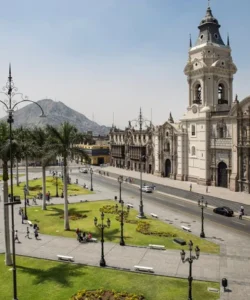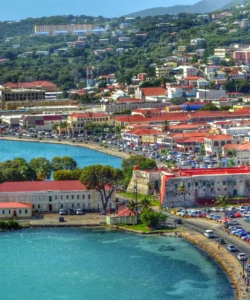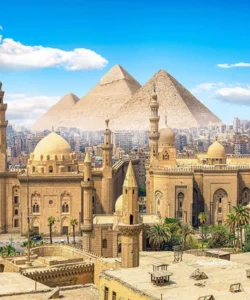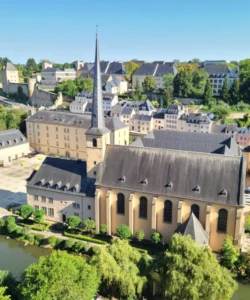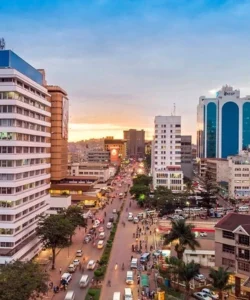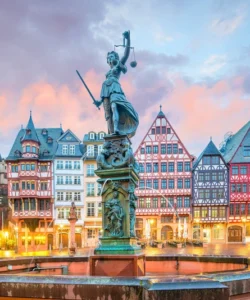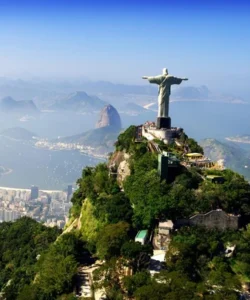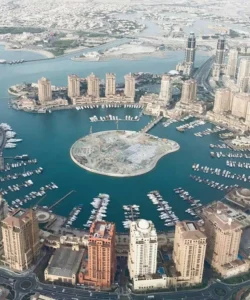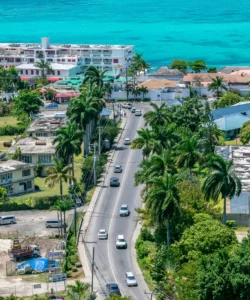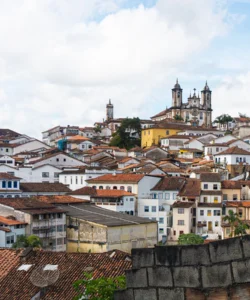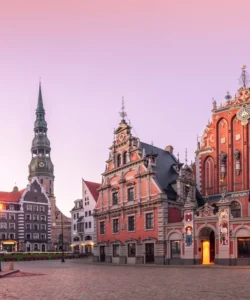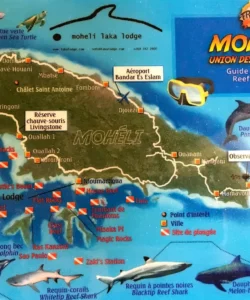Albania, officially the Republic of Albania, is a country in Southeast Europe, situated on the Adriatic and Ionian Seas within the Mediterranean Sea. It is known for its stunning coastline, rugged mountains, ancient ruins, and a unique cultural heritage shaped by centuries of diverse influences.
Listen to an introduction about Albania
![]()
Area and Population:
Albania covers an area of approximately 28,748 km² (11,100 sq mi). As of early 2025, its population is estimated to be around 2.82 million.
Capital:
The capital city of Albania is Tirana.
Major Cities:
Besides Tirana, other significant cities include Durrës (a major port city), Vlorë (historically important), Elbasan, and Shkodër.
Language:
The official language of Albania is Albanian. It has two main dialects: Tosk (spoken in the south) and Gheg (spoken in the north). Due to historical ties and diaspora, Italian, Greek, and English are also widely spoken, especially among younger generations.
Currency:
The official currency of Albania is the Albanian Lek (ALL).
Religion:
As a legacy of nearly five centuries of Ottoman rule, Albania is a predominantly Muslim country. However, due to the strict enforcement of atheism during the communist regime, many Albanians today practice largely secular lifestyles, with religious adherence often nominal. There are also significant communities of Roman Catholics and Orthodox Christians.
Attractions and Wonders:
- Albanian Riviera: A stunning stretch of coastline along the Ionian Sea, featuring pristine beaches, crystal-clear waters, and charming coastal villages like Ksamil, Dhermi, and Himarë.
- Butrint National Park: A UNESCO World Heritage site, this archaeological park showcases ruins from ancient Greek, Roman, Byzantine, and Venetian civilizations, set in a beautiful natural landscape.
- Berat (City of a Thousand Windows): Another UNESCO World Heritage site, known for its Ottoman-era houses cascading down a hillside, crowned by a medieval castle.
- Gjirokastër (Stone City): A UNESCO World Heritage site, this Ottoman-era town is famous for its unique stone houses, steep cobbled streets, and impressive castle.
- Krujë Castle and Bazaar: Perched on a hilltop, this historic castle was the stronghold of Albania’s national hero, Skanderbeg. The old bazaar below offers traditional crafts and souvenirs.
- Theth and Valbonë Valleys (Albanian Alps): Located in the “Accursed Mountains” (Bjeshkët e Nemuna), these national parks offer breathtaking landscapes, rugged peaks, traditional villages, and fantastic hiking opportunities. The hike between Theth and Valbonë is particularly popular.
- Blue Eye (Syri i Kaltër): A mesmerizing natural spring and natural phenomenon near Sarandë, known for its incredibly vibrant turquoise and deep blue colors.
- Apollonia Archaeological Park: The ruins of an ancient Greek city, once an important Roman city, offering impressive structures and a museum.
- Rozafa Castle, Shkodër: A historic castle overlooking Shkodër, with legends surrounding its construction and offering panoramic views of Lake Shkodër and the rivers.
- Bunk’Art, Tirana: Former communist bunkers converted into museums, offering insights into Albania’s totalitarian past.
Architecture:
Albanian architecture is a blend of various historical influences, from antiquity to the modern era:
- Illyrian and Ancient Greek/Roman: Evident in archaeological sites like Butrint, Apollonia, and Byllis, featuring remnants of temples, theaters, and fortifications.
- Byzantine: Churches and monasteries with distinctive domes and frescoes, particularly in the south.
- Ottoman: Predominant in historic towns like Berat and Gjirokastër, characterized by stone houses with distinctive roofs, narrow cobblestone streets, and mosques.
- Venetian: Fortifications and coastal castles (e.g., Porto Palermo Castle) show Venetian influence.
- Austro-Hungarian and Italian: In the late 19th and early 20th centuries, some urban centers like Tirana and Korçë saw the introduction of Art Nouveau, Neoclassical, and Neo-Renaissance styles.
- Communist Era: Marked by socialist realist architecture, large concrete blocks, and the widespread construction of bunkers.
- Post-Communist and Contemporary: A surge of new construction, with varied styles, from modern residential buildings to new public infrastructure, often reflecting a blend of international trends and local adaptations.
Roads:
Albania’s road network has seen significant improvements in recent decades, particularly since the early 2000s, but quality can still vary.
- Motorways (Autostrada – A-roads) and Expressways (Rruga Shtetërore – SH-roads): Key arteries connect major cities like Tirana, Durrës, and Vlorë, and extend towards Kosovo. The A1 motorway is a major north-south corridor. These main roads are generally in good condition, with modern signage. Some motorways are tolled.
- Regional and Local Roads: While main roads have improved, some rural and mountain roads can still be narrow, winding, unpaved, or in poor condition, requiring caution, especially in remote areas.
- Mountain Passes: Scenic but challenging roads like Llogara Pass offer spectacular views along the Riviera but require careful driving.
Driving can be an adventure, but the improved infrastructure makes exploring the country increasingly accessible.
Hotels:
Albania’s tourism sector has been rapidly expanding, leading to a growing variety of accommodation options:
- International Chains: Major cities like Tirana and coastal resorts increasingly feature international hotel brands (e.g., Marriott, Hilton Garden Inn, Radisson Collection).
- Luxury and Boutique Hotels: Especially in Tirana, Sarandë, and Durrës, offering modern amenities and stylish designs.
- Coastal Resorts: Along the Albanian Riviera, a wide range of hotels, resorts, and apartments cater to beach tourism, from luxury establishments to more budget-friendly options.
- Traditional Guesthouses (Bujtina): In historic towns like Berat and Gjirokastër, and in mountain villages (e.g., Theth, Valbonë), you can find charming guesthouses offering an authentic experience and local hospitality.
- Hostels: Available in major cities and popular backpacker destinations.
Restaurants and Cuisine:
Albanian cuisine is a delicious blend of Balkan, Mediterranean, and Ottoman influences, known for its freshness, seasonality, and hearty flavors.
- Tavë Kosi: Considered a national dish, it’s a baked lamb and yogurt casserole, often seasoned with garlic and oregano.
- Byrek: A flaky, savory pie made with thin layers of dough, often filled with spinach and cheese (gjizë), minced meat, or leeks. A popular street food.
- Fërgesë: A traditional dish, especially from Tirana, made with peppers, tomatoes, cottage cheese, and sometimes liver, baked until creamy.
- Qofte: Flavorful meatballs, usually made from minced beef or lamb, herbs, and spices, often served with yogurt sauce.
- Speca të Mbushura: Stuffed bell peppers, typically filled with rice, minced meat, and vegetables.
- Flija: A unique layered pancake-like dish, traditionally cooked on an open fire with a special domed lid (sač). Each layer is cooked individually, creating a delicious texture, often served with yogurt or honey.
- Seafood: Given its coastline, fresh seafood is abundant, especially along the Riviera.
- Olives and Olive Oil: Widely used in cooking.
- Salads: Fresh vegetable salads are common, often dressed simply with olive oil and lemon.
- Desserts: Influenced by Ottoman traditions, common desserts include Baklava, Revani (semolina cake), and Trileçe (three-milk cake).
- Drinks:
- Raki: A strong alcoholic drink, often homemade, made from fermented fruits like grapes, plums, or mulberries.
- Konjak (Cognac): Albanian brandy is also produced.
- Local Wine: Wine production is growing, especially in regions like Korçë and Berat.
- Coffee: Turkish coffee and espresso are very popular.
Dining experiences range from simple family-run restaurants and casual eateries serving traditional fare to more upscale establishments in Tirana and coastal towns, offering modern Albanian and international cuisine.

